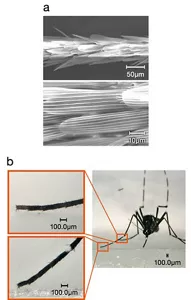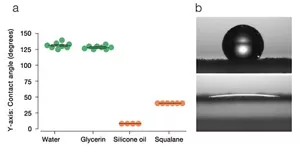Repellent Research Focusing on Mosquito Blood-sucking Behavior
Mosquito Leg Structure and Wetting Phenomenon
Research results on the structural features of mosquito legs and the contact angle on the target surface are introduced.
Mosquito leg structure
Mosquitoes use the water surface as a scaffolding during emergence and spawning; thus, their legs are highly water repellent [1]. This is because, as shown in Fig. 1, the surface of mosquito legs is covered with scales and with a fine uneven structure. Kao focused on the characteristics of mosquito legs and is conducting research on the affinity between mosquito legs and substances.
Features of mosquito legs and contact angles
When water droplets are dropped on a board that imitates the surface of a mosquito leg (a board with scales on the mosquito’s leg) and the contact angle is measured, the contact angle can be as high as 130.8 (it is said that the maximum contact angle of water is 119 °on a smooth surface without unevenness [2]). However, it is understood that such an uneven structure makes it easy for hydrophobic liquids to get wet. As shown in Figure 2, both silicone oil and squalane have low contact angles. When applying silicone oil as a cosmetic material, contact angle dropping after 1 s was 8.2°, and droplets continued to spread even after measurement.
Fig. 1 Microscopic image of a mosquito



(a) Electron microscope image of the front legs, scale bar is 50μm (upper image), 10µm (lower image) (b) Digital microscope image, scale bar is 100μm (reference: modified from Iikura et al., Sci Rep 10, 14480 [2020]).
Fig. 2 Contact angles of various liquids with respect to the substrate using scales covering the mosquito leg surface.



(a) Samples with different contact angles for each liquid. (b) Glycerin (upper figure) and silicone oil (lower figure) droplets 1 s after drop placement (reference: modified from Iikura et al., Sci Rep 10, 14480 [2020])
Refernce:
-
[1]Wu, C. W., Kong, X. Q. & Wu, D. Micronanostructures of the scales on a mosquito’s legs and their role in weight support. Phys. Rev. E 76, 017301 (2007).
-
[2]Nishino, T., Meguro, M., Nakamae, K., Matsushita, M. & Ueda, Y. The lowest surface free energy based on-CF3 alignment. Langmuir 15, 4321–4323 (1999).
- Home
- Innovation
- Research & Development
- Infectious Disease Control Study Dengue Virus Mosquito Research
- Repellent Research Focusing on Mosquito Blood-sucking Behavior
- Mosquito Leg Structure and Wetting Phenomenon
- Home
- Innovation
- Research & Development
- Infectious Disease Control Study Dengue Virus Mosquito Research
- Repellent Research Focusing on Mosquito Blood-sucking Behavior
- Mosquito Leg Structure and Wetting Phenomenon
